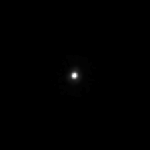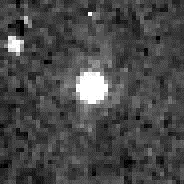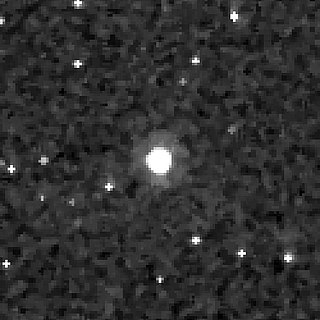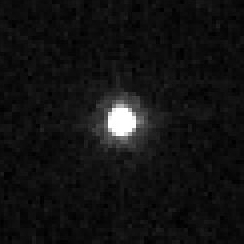
19521 Chaos is a cubewano, a Kuiper-belt object not in resonance with any planet. It is a possible dwarf planet, but is likely not a solid body. Chaos was discovered in 1998 by the Deep Ecliptic Survey with Kitt Peak's 4 m telescope. Its albedo is 0.050+0.030
−0.016, making it, with its absolute magnitude (H) of 4.8, 600+140
−130 km in diameter. It is named after the primeval state of existence in Greek mythology, from which the first gods appeared.
(84719) 2002 VR128, also written (84719) 2002 VR128, is a trans-Neptunian object (TNO). It was discovered in 2002 by Michael Brown and Chad Trujillo. The object is a plutino, an object in 2:3 orbital resonance with Neptune.

(307261) 2002 MS4 is a large classical Kuiper belt object and a possible dwarf planet in the Kuiper belt, a region of icy planetesimals beyond Neptune. It was discovered in 2002 by Chad Trujillo and Michael Brown. 2002 MS4 has been observed 74 times, with precovery images back to 8 April 1954.

(208996) 2003 AZ84 is a trans-Neptunian object with a possible moon from the outer regions of the Solar System. It is approximately 940 kilometers across its longest axis, as it has an elongated shape. It belongs to the plutinos – a group of minor planets named after its largest member Pluto – as it orbits in a 2:3 resonance with Neptune in the Kuiper belt. It was discovered on 13 January 2003, by American astronomers Chad Trujillo and Michael Brown during the NEAT survey using the Samuel Oschin telescope at Palomar Observatory.

(145452) 2005 RN43, also written as (145452) 2005 RN43, is a classical Kuiper belt object. It has an estimated diameter of 679+55
−73 km. It was discovered by Andrew Becker, Andrew Puckett and Jeremy Kubica on 10 September 2005 at Apache Point Observatory in Sunspot, New Mexico. Brown estimates that it is possibly a dwarf planet.

(84922) 2003 VS2 is a trans-Neptunian object discovered by the Near Earth Asteroid Tracking program on 14 November 2003. Like Pluto, it is in a 2:3 orbital resonance with Neptune and is thus a plutino. Mike Brown's website lists it as "likely" a dwarf planet. However, Brown assumed that 2003 VS2 was significantly larger than it really is, and analysis of its light-curve suggests that it may not be in the hydrostatic equilibrium.

(15875) 1996 TP66, provisional designation 1996 TP66, is a resonant trans-Neptunian object of the plutino population, located in the outermost region of the Solar System, approximately 154 kilometers (96 miles) in diameter. It was discovered on 11 October 1996, by astronomers Jane Luu, David C. Jewitt and Chad Trujillo at the Mauna Kea Observatories, Hawaii, in the United States. The very reddish RR-type with a highly eccentric orbit has been near its perihelion around the time of its discovery. This minor planet was numbered in 2000 and has since not been named. It is probably not a dwarf planet candidate.

(119951) 2002 KX14, also written as 2002 KX14, is a medium sized trans-Neptunian object (TNO) residing within the Kuiper belt. It was discovered on 17 May 2002 by Michael E. Brown and Chad Trujillo.

(469372) 2001 QF298, provisionally known as 2001 QF298, is a resonant trans-Neptunian object that resides in the Kuiper belt in the outermost region of the Solar System. It was discovered on August 19, 2001 by Marc W. Buie. 2001 QF298 is a plutino, meaning that it is locked in a 3:2 orbital resonance with Neptune, much like Pluto.

2006 QH181, also written as 2006 QH181, is a trans-Neptunian object (TNO). It is very likely a dwarf planet, and is part of the scattered disc. Its orbit is currently too poorly determined (U=6) to know whether it is in a resonance with Neptune.

(455502) 2003 UZ413, also written as 2003 UZ413, is a trans-Neptunian object (TNO) with an absolute magnitude of 4.38. It is in a 2:3 orbital resonance with Neptune, thus it is classified as a plutino. It is likely large enough to be a dwarf planet. It was given the minor planet number 455502 on 22 February 2016.

(202421) 2005 UQ513, also written as 2005 UQ513, is a cubewano with an absolute magnitude of 3.4. Mike Brown's website lists it as a highly likely dwarf planet. (202421) 2005 UQ513's spectrum has a weak signature of absorption by water ice. Like Quaoar, it has a very red spectrum, which indicates that its surface probably contains many complex, processed organic molecules. Its light curve shows variations of Δm=0.3 mag, but no period has been determined.
(303775) 2005 QU182, also written as (303775) 2005 QU182, is a trans-Neptunian object with a bright absolute magnitude of ca. 3.6. Mike Brown lists it as probably a dwarf planet.

(145480) 2005 TB190, provisionally known as 2005 TB190, is a trans-Neptunian object (TNO) with an absolute magnitude of 4.4, making it a likely dwarf planet.
(82075) 2000 YW134, provisionally known as 2000 YW134, is a binary trans-Neptunian object (TNO). It is likely in 3:8 resonance with Neptune or possibly a detached object.

471143 Dziewanna, exact:, provisional designation 2010 EK139, is a trans-Neptunian object in the scattered disc, orbiting the Sun in the outermost region of the Solar System.
(55638) 2002 VE95, also written as 2002 VE95, is a trans-Neptunian object (TNO) with an absolute magnitude of 5.7. A 2:3 orbital resonance with Neptune makes it a plutino.
(144897) 2004 UX10 is a Kuiper-belt object. It has a diameter of about 360 kilometres (220 mi) and was discovered by Andrew Becker, Andrew Puckett and Jeremy Kubica on 20 October 2004 at Apache Point Observatory in Sunspot, New Mexico. The object is classified as a cubewano. It is near a 2:3 resonance with Neptune.
(307463) 2002 VU130 (also written (307463) 2002 VU130) is a trans-Neptunian object (TNO). It was discovered in 2002 by Marc W. Buie at Kitt Peak Observatory. The object is classified as a plutino (in 2:3 resonance with Neptune).
2006 HJ123 (also written 2006 HJ123) is a trans-Neptunian object (TNO). It was discovered in 2006 by Marc W. Buie. The object is a plutino (in 2:3 resonance with Neptune).
















